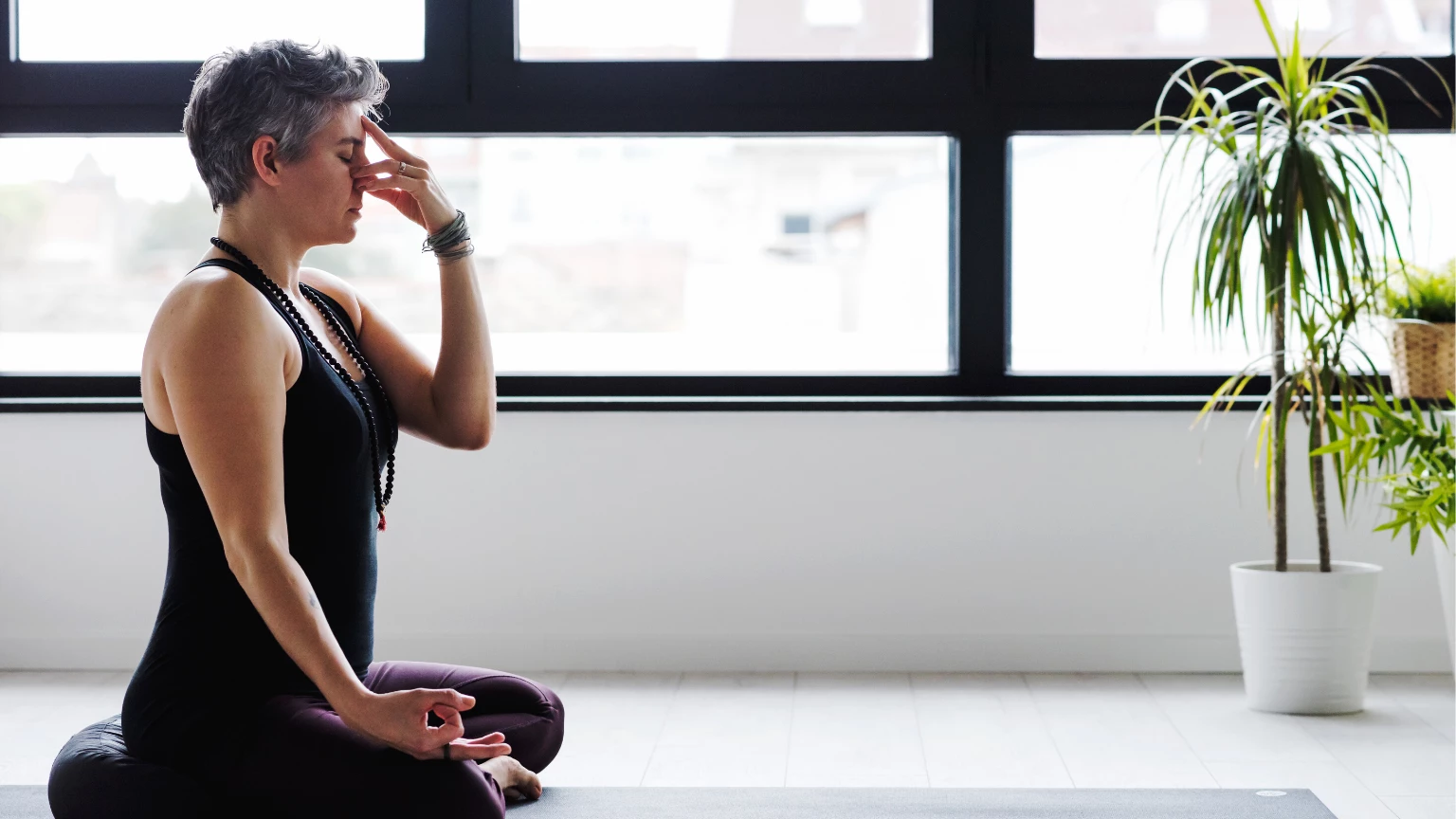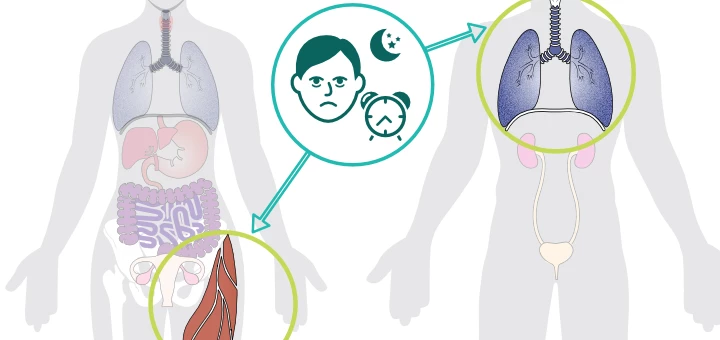Yogic Breathing for Better Sleep – Balancing Apana and Prana Vayus

Struggle with sleep problems or even insomnia? You are not alone.
Sleep problems become increasingly common as we age. According to the tradition of Ayurveda, this happens in part because Vata dosha becomes more dominant in the last one third of our lives.
Fortunately, there are ways to address sleep issues in a balanced way that may even lead you to discover some new approaches to keeping mind and body healthy. According to author and yoga therapist Gary Kraftsow, “Many sleep issues are daytime problems that show up at night.” Most physiological reasons for poor sleep need to be managed during the day via lifestyle changes, appropriate yoga practices, and other means. This quote also applies to other most common triggers of chronic insomnia—the psychological ones.
The key to better sleep, according to the yogic tradition, is balancing the Vayus. For this, yogic breathing can be particularly helpful. Here are some common sleep issues, and some yogic breathing practices that can be helpful.
Yogic Breathing Practices for Restless Leg Syndrome
Some people have an uncontrollable urge to move their legs at night because their legs feel uncomfortable. These sensations usually arise after being stationary for a while (sitting or lying down), and they feel different from muscle cramps or numbness. The sensations usually go away after some leg movement. Restless Leg Syndrome (RLS) typically doesn’t lead to other more serious conditions, but it can be very disruptive to sleep if it happens often.

According to Western medicine, there is no apparent cause to RLS. In the field of yoga therapy, we attribute RLS to Prana Vayu moving too far downward. Prana Vayu is one of five primary energetic channels that moves through the body; it flows downward and inward. It is primarily located in the head, lungs, and heart and is responsible for the neurological function (among other things).
RLS is viewed as an imbalance in Prana Vayu, with Prana “escaping” to the lower part of the body and creating a sense of restlessness. We turn to Apana Vayu management strategies to deal with this excess Prana energy in the lower body. Apana Vayu moves downward and outward and is responsible for discharging extra energy from the body. From a practical standpoint, it means doing some simple feet and ankle movements before bed with an emphasis on grounding and letting go.
How to Use the Breath to Balance Vayus
According to the yoga tradition, Prana and Apana Vayus are intimately linked within every breath cycle, with Prana guiding the inhalation and Apana guiding the exhalation part of the breath. Working with the breath by controlling the length of the inhalation and the length of the exhalation relative to one another helps to balance the flow of both Vayus.
Here is an example of a practice that helps to balance Prana and Apana Vayus.
This 30-minute practice uses breath and movement to link Prana and Apana Vayus (two main energetic currents in the body) to establish a stronger mind-body connection and increase the sense of vitality. A practice like that would have to be done at least two hours before bed to allow for sufficient unwinding time afterward.)
Using the Breath to Help Solve Breathing Difficulties
If you have trouble breathing at night, this is usually due to some obstruction in your throat, which can both wake you up at night and affect the quality of your sleep. Those obstructions can range from more benign, like snoring, to more serious, like obstructive sleep apnea.
Snoring usually happens when the tissues in your throat relax and partially block the airflow, which makes them vibrate when you breathe in, making that characteristic snoring sound. Obstructive sleep apnea, on the other hand, means that several times a night you stop breathing altogether for brief periods and then wake up with a gasp.
Snoring is more common while sleeping on the back, so changing your sleep position can often help end the snoring. My grandma also taught me a simple trick when I was little. She told me to gently rub the chest of the person who was snoring in small circles right under the neck. It takes three to four circles, and then the snoring usually stops.
I can attest to this. It works on my husband on rare occasions when he snores. At least it stops the snoring long enough for me to fall asleep. Of course, this won’t work for everybody or every time.
Working with the breath, in general, is a good idea when dealing with breathing difficulties. Increasing the breath threshold (tolerated length of the breath) is especially helpful. This has to be done very gradually, of course, under the guidance of an experienced teacher.
Exchange Snoring for Singing
Another traditional recommendation for dealing with snoring is chanting. Chanting is supposed to strengthen certain throat muscles. It works the same with singing – according to a study published in Medical News Today, certain singing exercises help reduce snoring. (1)
If snoring becomes disruptive or causes other symptoms, like drowsiness during the day, chest pains, or morning headaches, this could be a sign of sleep apnea, and then it is best to see a doctor. As my teacher sometimes says: “Don’t try to ‘yoga-out’ your way out of serious health concerns.” Seek professional help.
Other Physiological Causes of Insomnia
There are many different biological reasons for poor sleep, often related to specific diseases (like Parkinson’s) or side effects of certain medications (like asthma medicine). If your sleep suddenly becomes problematic, and you recently started taking some new medication for unrelated reasons, it is worth exploring if your medication is causing those problems. Analyze the timing, read the label, ask your doctor, and switch meds if necessary. Whichever ailment you are trying to recover from by using that medication, lack of sleep will likely impede the healing process, so it is best to address it.
Also, read...
15 Natural Remedies For A Good Night’s Sleep
Exploring the Link Between Sleep and Anxiety
Yogic Breathing for Better Sleep – Balancing Apana and Prana Vayus
Related courses

Educated as a school teacher, Olga Kabel has been teaching yoga for over 14 years. She completed multiple Yoga Teacher Training Programs but discovered the strongest connection to the Krishnamacharya/ T.K.V. Desikachar lineage. She had studied with Gary Kraftsow and American Viniyoga Institute (2004-2006) and received her Viniyoga Teacher diploma in July 2006, becoming an AVI-certified Yoga Therapist in April 2011. Olga is a founder and managing director of Sequence Wiz— a web-based yoga sequence builder that assists yoga teachers and yoga therapists in creating and organizing yoga practices. It also features simple, informational articles on how to sequence yoga practices for maximum effectiveness. Olga strongly believes in the healing power of this ancient discipline on every level: physical, psychological, and spiritual. She strives to make yoga practices accessible to students of any age, physical ability, and medical history, specializing in helping her students relieve muscle aches and pains, manage stress and anxiety, and develop mental focus.



